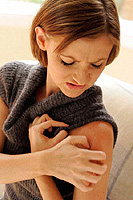What is photodermatitis? What is exogenous photodermatitis? What is endogenous photodermatitis? Answers to these questions you will find in the article.
Content
Photodermatitis (photodermatosis) - diseases due to increased skin sensitivity to the sunshine.
Manifest
Footmatrotis in the form of blisters, redness, itching and skin peeling,
arising after contact with the sun. As a rule, rashes arise
On the face, less often on the body, quite rare - on hand and legs. Since often disease
develops when leaving the sea, to the country with more active, unusual
For us sun.
The people of photodermatitis are often called
«Allergies in the Sun». However, as such, the allergic component
There is no sunny rays. Toxic or allergic sun action
manifests itself when the interaction of solar (ultraviolet) rays
With any substance that is on the skin (exogenous photodermatitis)
Or in the skin (endogenous photodermatitis).
What is exogenous photodermatitis
IN
The quality of the most vivid example of exogenous photodermatitis can be
Certify the so-called meadow dermatitis. In summer, during flowering,
Many meadow plants highlight special substances - Fourocumary,
which settle on the skin when finding a person in these places.
With the simultaneous impact of ultraviolet in some sensitive
People and bubbles can arise for people and bubbles (vesicles
and pustulas). Rashes are accompanied by a strong itch. Further
Long-term pigmentation remains on the affected skin.

Photodermatitis
may also occur if sensitive is sensitive before going
to him a man was ased with cream or ointment, or took advantage of the spirits
and deodorant. Substances included in various cosmetic or
Perfumes, can react with ultraviolet
rays and cause an allergic reaction. Such properties have,
For example, Eosin, which may be contained in lipstick,
and para-aminobenzoic acid (Pava), which is part of some
Sunscreen creams. In addition, a similar action possess
Polyunsaturated fatty acids, retinoids, butter Bergamot, Hypericum,
Roses, Musk, Sandal, Dopop Juice, Parsley, Borne, Salicyl
Acids, phenol, mercury drugs.
Therefore, collecting cosmetic
For relaxation at sea, it is advisable to explore the composition of perfumery
and cosmetics planned to take with you. And, from sin away,
postpone the one in which the above substances.
Why alone
People smoothly and beautifully sunbathe, even stern spirits, and others
Blisters are covered? Sometimes it is connected with the presence of any
chronic disease, especially liver or adrenal glands. More often
Other photodermatitis suffer from light skin and small children,
whose mechanisms of protective skin reaction are much weaker.
Many
Drugs also contribute to the emergence of photodermatitis.
Such an effect possess, in particular, sulfonamides, barbiturates,
Aminazine, some antibiotics (doxycycline, tetracycline),
Antihistamines, Some Cardiovascular Tools
(amiodaron, trashcorcor), cytostatics, some nonsteroidal
Anti-inflammatory drugs (ibuprofen, aspirin), oral
Contraceptives.
In addition, the increased skin reaction to the sunny
Rays appear when the skin «Weakened» some additional
exposure to peeling, tattime using cadmium salts.
What is endogenous photodermatitis
TO
This group of photodermatites includes quite rare
Diseases in the development of which violations are played in the development of
Immune system of the body, as well as various metabolic disorders
(Violations in the metabolism). Endogenous photodermatites include,
In particular, Porphyria, Pigment Keroderma, Solar Eczema,
Solar Scratch, Hydroa Vacciniformia (Hydro Vaccinoform),
polymorphic photodermatosis.
All these states require
close attention of specialists (dermatologists, immunologists,
Allergists) and careful examination.









